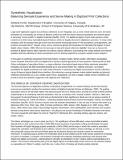Files in this item
Synesthetic visualization: balancing sensate experience and sense making in digitized print collections
Item metadata
| dc.contributor.author | Forlini, Stefania | |
| dc.contributor.author | Hinrichs, Uta | |
| dc.date.accessioned | 2017-06-21T11:30:11Z | |
| dc.date.available | 2017-06-21T11:30:11Z | |
| dc.date.issued | 2017-06-14 | |
| dc.identifier | 250168025 | |
| dc.identifier | bfed6eb5-4d26-4bef-a43d-6289830cbb73 | |
| dc.identifier.citation | Forlini , S & Hinrichs , U 2017 , Synesthetic visualization: balancing sensate experience and sense making in digitized print collections . in Proceedings of the conference on Digital Preservation for Social Sciences and Humanities . Digital Preservation for Social Sciences and Humanities , Brighton , United Kingdom , 14/06/17 . | en |
| dc.identifier.citation | conference | en |
| dc.identifier.uri | https://hdl.handle.net/10023/11041 | |
| dc.description.abstract | Large-scale digitization appears to put literary collections at one’s fingertips, but, as some critical observers warn, the books themselves are increasingly out of reach as libraries continue to shift from being “physical repositories and research spaces” to becoming “access portals” to digitized materials (Stauffer, 2012). The digital surrogates of print books preserve verbal content but not their many meaningful physical features, which are largely obscured in digitization processes. As many critics recognize, with the passing of the age of print we have become increasingly aware of “the assumptions, presuppositions, and practices associated with it” (Hayles, 2012), and by contrast we glimpse the devaluation of materiality that appears to haunt digital culture (Hayles, 1999). What are the best ways to treat print-based collections digitally? How can we harness the potential of digital media to better represent and analyze cultural collections, accentuating their unique aesthetic and material qualities while also allowing for diverse perspectives and rich linking supported by computer-assisted content analyses? In this paper we synthesize perspectives from book history, reception studies, literary studies, information visualization, human computer interaction (HCI) and digital arts to discuss practical approaches to these questions. Working with the Bob Gibson anthologies of speculative fiction—a unique collection of periodical-based science fiction selectively assembled, annotated, and bound into 888 handcrafted booklets by an avid science fiction fan, collector and artist—we explore possibilities for digital synesthesia and multi-modal interaction in sketching how digital representations of print collections can go far beyond typical digital library interfaces. By embracing a synergy between content-related metadata and physical artifactual characteristics (e.g. size, weight, paper texture, typography), we seek to engage multiple sensory modalities and provoke critical and aesthetic engagement with digitized print collections. | |
| dc.format.extent | 103211 | |
| dc.language.iso | eng | |
| dc.relation.ispartof | Proceedings of the conference on Digital Preservation for Social Sciences and Humanities | en |
| dc.subject | Digital Humanities | en |
| dc.subject | Information visualization | en |
| dc.subject | Digital collections | en |
| dc.subject | H Social Sciences | en |
| dc.subject | QA75 Electronic computers. Computer science | en |
| dc.subject | Z665 Library Science. Information Science | en |
| dc.subject | NS | en |
| dc.subject.lcc | H | en |
| dc.subject.lcc | QA75 | en |
| dc.subject.lcc | Z665 | en |
| dc.title | Synesthetic visualization: balancing sensate experience and sense making in digitized print collections | en |
| dc.type | Conference item | en |
| dc.contributor.institution | University of St Andrews. School of Computer Science | en |
| dc.date.embargoedUntil | 2017-06-14 |
This item appears in the following Collection(s)
Items in the St Andrews Research Repository are protected by copyright, with all rights reserved, unless otherwise indicated.

